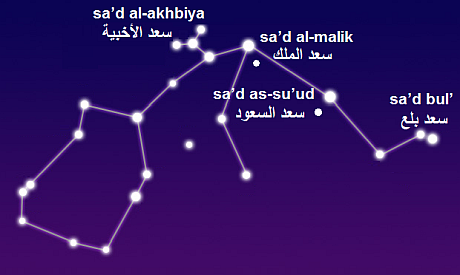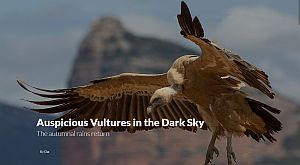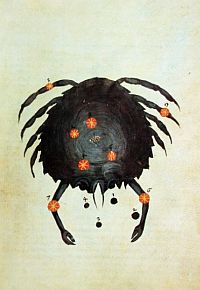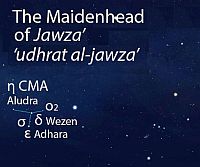


|
|
Middle EastMiddle Eastern Star LoreA - D |
|



|
|
Andromeda
|

|
|
As-Samakatan - Two Fishes in the Arabian Desert
Before Abd al-Rahman al-Sufi and other Arabic astronomers adopted
Ptolemy's constellations, people on the
Arabian Peninsula had their own way to navigate the sky, creating constellations like Lam, Ostriches and
Vulture.
|
 The two fish; presentation by Danielle Adams
The two fish; presentation by Danielle AdamsSource: Arab Star Calendars |

Danielle Adams points out that "not all features of the Two Fish were necessarily shared by the same group of people. This listing is necessarily anachronistic
because of the limited information that remains."
 In her description, the Great Fish, al-hut or as-samaka al-‘azima consisted of β, ν and μ Andromedae, υ, φ, χ and ψ Piscium, η, ζ, ε, δ and π Andromedae and the Andromeda_Galaxy.  β Andromedae receives a special mentioning as batn al-hut, the "Belly of the Fish."  George R. Davis, Jr. describes al-hut naming the same stars as Danielle Adams, adding ν Piscium and the galaxy M 32 to the list.  According to Danielle Adams, "the Great Fish is a very old asterism dating back to Babylonian times. The Smaller Fish is likely not as old, but its origin is unknown." |
 In her description, as-samaka as-sughra, the Smaller Fish, consists of γ Andromedae, which is called "The Belly", τ, υ, χ and 51 Andromedae, φ Persei and the double cluster of NGC 869 and NGC 884.  For more information on this ancient Arab constellation, see D. Adam's essay Ancient Fish in the stellar Sea: Remnants of Babylon. |

|



|
|
Medieval Arab Astronomy
R.H. Allen reports that
Arabian astronomers depicted the constellation as a "Sea Calf, or Seal ... with a chain around its neck that united it to one of the Fishes", as their
religion prohibited the reproduction of human images.
|
 Al-Sufi's version of Andromeda
Al-Sufi's version of Andromedanon-dated copy from Samarkand Source: Venetian Andromeda |

|

|
Official names derived from Arabic origins are shown in bold.
|

The name of Andromeda's brightest star Alpheratz ( α And) is derived from
the Arabic surrat al-faras "the navel of the mare." another traditional Arabic name was rās al-mar'a al-musalsala, "the head of the woman
in chains". The "mare" refers to Pegasus, while the "woman in chains" of course was
Andromeda.
 Until 1928 when the IAU explicitly defined the boundararies of the constellations (published in 1930), Alpheratz was considered a star of both constellation.  Source: Wikipedia
Mirach, (β And) was originally called janb al-musalsalah, "The Side of the Chained
Lady" by medieval Arab astronomers. That name clearly referred the the Andromeda legend, while another common Arab name,
Qalb al-Ḥūt, the "Heart of the Fish," referred to the al-Ḥūt constellation.
Almach (γ And) is derived from the Arabic al-‘anāq, meaning
Desert Lynx. In 2016, the name was officially approved by the
IAU.
Sadiradra (δ And) comes from the Arabic sadar aleadhra, the virgin's breast.
Keff al-Salsalat is the name al-Muwaqqit used for ι Andromedae, derived from
kaf al-musalsala, the palm of chained woman.
The traditional Arab name Adhil (ξ And) comes from the Arab word
að-ðayl, meaning train or tail - most likely another reference to the al-Hut constellation.
|
 1125 copy of Al-Sufi's Andromeda
1125 copy of Al-Sufi's AndromedaDoha Museum of Islamic Art
|


|
|
Andromeda Galaxy in al-Sufi's Book of Fixed Stars
The Andromeda Galaxy is the nearest major galaxy to the Milky Way. although its true character as
a galaxy was not recognized until 1917, it was known to astronomers as a
"nebula" at least since the 10th century.
|
 14th century copy of al-Sufi's depiction of the Andromeda Galaxy
14th century copy of al-Sufi's depiction of the Andromeda GalaxySources: University of Oregon, Universität zu Köln |



|
|
Aquarius Arabian Peninsula: as-su’ud - The Auspicious Asterisms
The Auspicious Asterisms are one of eleven
Folkloric Celestial Complexes identified in the Arabic Star Catalog, developed by
Danielle Adams at the University of Arizona in Tucson.
|

|

Four of the Auspicious Asterisms are located in Aquarius. Three of those also represent three of the
Arabic Lunar Stations.
 ε and μ Aquarii form sa’d bul’ (سعد بلع), the Voracious Auspice or sa’d al-bali’ (سعد البالع), the Auspice of the Voracious Eater. They also represent the 23rd Lunar Station.  The Auspice of Auspices, sa’d as-su’ud (سعد السعود) was formed by β and ξ Aquarii, which also formed the 24th Lunar Station.  The "double luck" asterism was the most sought after for good fortune among the ten Auspicious Asterisms. |
 Auspicious Asterisms in Aquarius;
Map based on seasky.org
Auspicious Asterisms in Aquarius;
Map based on seasky.org
|

Sa’d al-akhbiya (سعد الأخبية) the The Auspice of Woolen Tents, is formed by
three stars,
γ,
η and
π Aquarii in the shape of a triangular tent, with a fourth star,
ζ Aquarii in the center.
 The four stars also represent the 25th Lunar Station.  Sa’d al-malik (سعد الملك), the Auspice of the King consists of the second brightest star in Aquarius, α Aquarii and rather faint nearby ο Aquarii.  With slightly different spelling, the asterisms are also listed by R.H. Allen.  Source: Arab Star Calendars |
 Tent in the Arabian Desert;
dreamstime.com
Tent in the Arabian Desert;
dreamstime.com
|


|
|
Medieval Arab Astronomy
R.H. Allen points out that the religion of
Islam prohibited the depiction of humans or human-like figures and that therefore, several Islamic astronomers showed the constellation as an amphora
(Al Bīrūnī) or as a water bucket
(Ulugh Beg).
|
 Aquarius in a version of Al-Sufi's Book of Fixed Stars
Aquarius in a version of Al-Sufi's Book of Fixed StarsSource: sciencephoto.com |

|

|
Official names derived from Arabic origins are shown in bold.
|


|
Today's names of Aquarius' three brightest stars are directly derived from the Auspicious Asterisms
(see above).
The name Sadalmelik (α Aqu) is derived from sa’d al-malik, the Auspice of the King.
The name of Aquarius' brightest star, Sadalsuud (β Aqu), comes from
sa’d as-su’ud, the The Auspice of Auspices. Originally,
β Aqu was called nir sa’d as-su’ud, the brightest of the Auspice of Auspices, while
ξ Aqu was called thanih sa’d as-su’ud, the second of the Auspice of Auspices.
Sadachbia (γ Aqu) was derived from sa’d al-akhbiya,
the Auspice of Tents.
The name Skat (δ Aqu) comes from al-sāq (الساق) - shin. The star is not part of any of the Auspices.
The name Albali (ε Aqu) comes from sa’d al-bali’, the
Auspice of the Voracious Eater, also known as "The Swallower."
|
 Aquarius in Book of Fixed Stars
Aquarius in Book of Fixed Starsof Alfonso the Wise, 1279 Source: facsimilefinder.com
|



|
|
Aquila Arabian Peninsula: an-nasran - The Two Vultures
The Two Vultures are one of eleven
Folkloric Celestial Complexes identified in the Arabic Star Catalog, developed by
Danielle Adams at the University of Arizona in Tucson.
|
 The Two Vultures; presentation by Danielle Adams
The Two Vultures; presentation by Danielle AdamsSource: Arab Star Calendars |

an-nasr al-ta’ir (النسر الطائر), the
Flying Vulture consists of the bright stars
α, β and
γ Aquilae.
 The other vulture, the Alighting Vulture is located in what is now the constellation Lyra.  For more information on this ancient Arab constellation, see Danielle Adams' essay Auspicious Vultures in the Dark Sky: The autumnal rains return.  Source: Arab Star Calendars |

|

In the ancient, tragic Arab legend of Jawza’ and Suhayl,
the bright star Canopus (α Car) represents Suhayl, who had to flee to the south after
the death of his wife Jawza’ (presented by Orion's Belt).
 Source: Arab Star Calendars |


|
|
Medieval Islamic Astronomy In his Book of Fixed Stars, Persian astronomer Abd al-Rahman al-Sufi relate Greek star names and constellations with traditional Arabic ones.
The name Altair (α Aqi) comes directly from the classical
Flying Vulture, which today is seen as a flying eagle. Danielle Adams explains that in
modern-day Arabic, the term nasr indicates an eagle, but at the time the constellation was first observed it was more commonly used for vultures.
The name Alsahin (β Aqi) is derived from the Persian term šāhin tarāzu
(شاهين ترازو), meaning the Beam of the Scale, which was an asterism consisting of
α,
β and
γ Aquilae.
|

Aside from meaning "beam" or "pointer," the Persian word al-šāhin can also mean "royal falcon."
 Source: Wikipedia
The second word of the šāhin tarāzu asterism is the root of the name Tarazed (γ Aqi).
Another traditional Arabic formation going with the "scale" theme is Al Mizān (ألميزان), the Balance. This asterism consists of
δ,
η and
θ Aquilae, which are unofficially still named Al Mizān I, II and III, respectively.
|

ε and ζ Aquilae bore the traditional Arabic
name Deneb el Okab, derived from the Arabic ðanab al-ʽuqāb (ذنب العقاب), the tail of the eagle. Later, the stars received the additional Latin extension
Borealalis (ε Aqi) and Australis (ζ Aqi), meaning northern and southern.
 In 2016, the IAU officially assigned the name Okab to ζ Aquilae A.  Source: Wikipedia
λ and ι Aquilae share the traditional Arabic name
Al Thalimain, derived from al-ẓalīmayn (الظلیمين), the two ostriches.
|
 Colored reproduction of al-Sufi's illustration, Bologna 1250-1275
Colored reproduction of al-Sufi's illustration, Bologna 1250-1275pinterest.it
|

In his Pearls of Brilliance, 17th century Egyptian astronomer
al-Muwaqqit used a number of unique Arabic names for some of the stars of Aquila.
 δ Aquilae was named Djenubi Menkib al Nesr (منكب ألنسر ألخنوبي), the southern shoulder of the eagle, θ Aquilae was named Thanih Ras al Akab (تاني ألرأس ألعقاب), the second (star) of eagle's head and ζ Aquilae was named Dzeneb al Tair (ذنب الطائر), the eagle's tail. |



|
|
Argo Navis |

|
|
Medieval Arab Astronomy
Most Arabic astronomers adopted Ptolemy's constellation.
|
 Argo Navis in a 1417 reproduction of Al-Sufi's Book of Fixed Stars
Argo Navis in a 1417 reproduction of Al-Sufi's Book of Fixed StarsSource: sciencephoto.com |



|
|
Aries |

|
|
Hebrew astronomy
In Hebrew astronomy, Aries was named טלה (Taleh); it generally symbolizes the "Lamb of the World".
The image to the right shows the Adoration of the Mystic Lamb, the center piece of the 15th century Ghent Altarpiece, generally considered the first major oil painting to gain global fame. |
 Ghent Altarpiece;
BBC News
Ghent Altarpiece;
BBC News
|


|
|
Arabian Peninsula: al-hamal - The Lamb
al-hamal (الحمل), The Lamb, is one of eleven
Folkloric Celestial Complexes identified in the Arabic Star Catalog, developed by
Danielle Adams at the University of Arizona in Tucson.
|

|

| qarna al-hamal (قرنا الحمل), The Two Horns of the Lamb were formed by α and β Arietis. Individually, the two stars were called al-nath (النطح), the Butting (α Ari) and al-natih (الناطح), the Butter (α Ari). |

|
β Arietis, together with γ Arietis were also called
aš-šaraţān, the two signs, referring to the fact that the two stars once
marked the northern vernal equinox. They formed the First Arabic Lunar Mansion.
al-butayn (البطين), the The Little Belly,, also called
batn al-hamal (بطن الحمل), the The Belly of the Lamb originally
(according to Danielle Adams) most likely consisted of the stars 41,
39 and 35 Ari.
|
 Possible stars of al-butayn
Possible stars of al-butaynMap based on seasky.org |

|
alyat al-hamal (ألية الحمل), the
The Fatty Tail of the Lamb was made up by the
Pleiades. More information can be found
here. For more information on this ancient Arab Lamb complex, see Danielle Adams' essay The Little Lamb that Changed the Calendar: The vernal equinox in Arabia. |

|


|
|
Medieval Islamic Astronomy
Most of the main stars in Aries carry traditional Arabic names.
Persian astronomer Abd al-Rahman al-Sufi based his description on
Ptolemy and depicted the constellation as a ram. Others, however, saw it as a "nondescript four-legged animal with what may be antlers instead of
horns," as shown in some Islamic celestial globes.
Hamal (α Ari), the brightest star in Aries lends its name to the entire constellation. It is derived
from the Arabic rās al-ħamal, the "head of the ram."
The name Sheratan (β Ari) stems from the Arabic aš-šaraţān, "the two signs" (see above).
The name Mesarthim (γ Ari) is a classic example of misinterpretation. Originally, the star shared the name Sheratan with β Arietis. According to Wikipedia, in medieval manuscripts the name Sheratan got corrupted to Sartai. |
 13th century Spanish copy of al-Sufi's illustration
13th century Spanish copy of al-Sufi's illustrationin the Book of Fixed Stars; © akg-image
|

In 1803, when Johann Bayer developed his star catalogue
Uranometria, he erroneously interpreted that name as
the Hebrew word מְשָׁרְתִים (mᵉshārᵉthīm), meaning
"servants." Later scholars picked up on the term, for example, the English astronomer
William Henry Smyth (1788-1865) called it Mesartun - and so, the name stuck.
 Source: Wikipedia, Constellation of Words
The name Botein (δ Ari) is derived from
al-butayn (see above).
|



|
|
Cancer
According to R.H. Allen, Arab astronomers called
this constellation Al Saraṭān, meaning "Crab."
Cancer's two main stars still carry Arabic names today. The names of the two other stars are Latinised versions of former Arabic Names. |
 Colored copy of
Colored copy ofal-Sufi's illustration Source: researchgate.net
|

|

|
Official names derived from Arabic origins are shown in bold.
|


Acubens (α Cnc) is derived from the Arabic al-zubanāh, "The Claws."
 Sources: R.H. Allen, Wikipedia.
Tarf (β Cnc) comes from the Arabic al-tarf, meaning "The End. According to
R.H. Allen, the name refers to the end
"...of the southern foot on which it lies."
Adopting the Greek myth of the gods and their donkeys,
(see here), γ and δ Cancri were collectively known as
al-ḥimārain, "The Two Asses." The name was Latinized to Aselli. Individually, the two stars became
Asellus Borealis, "The Northern Ass" (γ Cnc) and
Asellus Australis, "The Soutern Ass" (δ Cnc).
γ and δ Cancri flank the
Beehive Cluster, an open star cluster that, to the naked eye, looks like a small nebulous object.
(The brightest star in the cluster is ε Cnc. According to Star-Facts,
the name Meleph for this star comes from the Arabic al-ma᾽laf, “the stall.”
|
 15th century copy copy of
15th century copy copy ofal-Sufi's illustration Pergamenthandschrift M II 141, Source:atlascoelestis.com
|



|
|
Canes Venatici |

|
|
The Borgian Globe
 The Borgian Globe is an Arabic celestial globe manufactured in 1225 and recovered in 1790 by Cardinal Stefano Borgia. It shows the Ptolemaic constellations, inscribed in Kufic characters.  In addition, it shows two constellations not shown on any other globe. One is an oval shape, enclosing eight stars in the location of the modern constellations Leo Minor and Lynx.  The other one is a square underneath the "Tail" of Ursa Major at the location of Canes Venatici.  |
 karab alebl on the Borgian Globe
karab alebl on the Borgian GlobeSource: atlascoelestis.com |
 R.H. Allen, referring to orientalist Assemani, called the formation al karb al ibl, the Camel's Burden. Felice Stoppa called it karab alebl, the Camel Pack.  Sources: R.H. Allen, atlascoelestis.com |


|
|
The Sultan's Tables
 In 1439, Timurid sultan and astronomer Ulugh Beg set a new standard in astronomical observation publishing the Sultan's Tables or Zij-i-Sultani.  In it, he called the star later known as α CVn Al Kabd al Asad. The name literally means "The liver of the Lion", referring to the Arabic celestial complex al Asad, the Lion. However, "Liver" in this case is not a biological term, but a technical one. According to R.H. Allen, it indicates "... the highest position of any star within the compass of a figure reckoned from the equator."  Source: R.H. Allen |



|
|
Canis Major |

|
|
Arabian Peninsula: udhrat al-jawza’ - The Maidenhead of Jawza’
Jawza’ is one of eleven
Folkloric Celestial Complexes identified in the Arabic Star Catalog, developed by
Danielle Adams at the University of Arizona in Tucson. It is centered in
Orion but also includes parts of
neighboring constellations.
|
 Presentation by Danielle Adams
Presentation by Danielle AdamsSource: Arab Star Calendars |
 Jawza's husband Suhayl came from the other side of the river (which is the Milky Way). After Jawza's tragic death, he had to flee to the south. One of his sisters, ash-shi’ra al-‘abur, the Shi’ra who crossed over, followed him. The two are represented by the two brightest stars in the night sky, Sirius (Suhayl) and Canopus (α Carinae - ash-shi’ra al-‘abur)  Sources: Arabic Star Catalog, R.H. Allen |


|
|
Medieval Arab Astronomy
In medieval Arab astronomy, the constellation became al-kalb al-akbar, "the Greater Dog", later transcribed as alcheleb alachbar.
The name Mirzam (β CMa) derives from the Arabic murzim (مرزم), meaning
"The Herald," most likely because of its position, heralding th rising before of Sirius
in the night sky.
Muliphein (γ Cen) comes from the Arabic muħlifayn (محلفين), meaning "Jurors."
The star shares its linguistical roots with the slightly differently spelled
Muhlifain (γ Centauri)
Wezen (δ CMa) derives from the medieval Arabic al-wazn (وزن), meaning
"Weight." Richard H. Allen suggest
the name describes the star's difficulty to rise above the horizon in the northern hemisphere.
The name Adhara (ε CMa) goes back to the ancient Arab al-‘adhara (the
Virgins) asterism (see above).
ο2 CMa was called thaanii al-aðārii, the "Second Virging
by
The name Aludra (η CMa) also has its roots in the original al-‘adhara (the
Virgins) asterism (see above).
Furud (ζ CMa) comes from the Arabic al-furūd (ألفرود), the "Solitary Ones,"
a name used by early Arab poets for a number of stars in the Canis Major and neigboring
Columba.
|

|


|
|
Sirius Reference in the Qur'an
Sirius is mentioned in the 53rd Surah,
An-Najm ("The Star"), of the
Qur'an, where it is given the
name الشِّعْرَى (aš-ši‘rā or ash-shira; the leader).
|


|
|
Ancient Persia
In Persian mythology, Sirius appears as
Tishtrya and is revered as the rain-maker divinity.
|
 Apaosha and Tishtrya
Apaosha and TishtryaSource: Twelve Gods of Persian Mythology
|



|
|
Canis Minor

|
|
|
Arabian Peninsula
The stars of Canis Minor are part of the ancient Arab legend of Jawza'.
|

|
|
Medieval Arab Astronomy
The medieval Arabic astronomers maintained the depiction of Canis Minor (al-Kalb al-Asghar in Arabic) as a dog; in his
Book of the Fixed Stars,
Abd al-Rahman al-Sufi included a diagram of the constellation with a canine figure
superimposed.
|
 Canis Major in Pergamenthandschrift M II 141,
Canis Major in Pergamenthandschrift M II 141,a 15th century copy of al-Sufi's drawing Source:atlascoelestis.com |



|
|
Cassiopeia
|

|
|
aydi ath-thuraya - the Hands of Thuraya
aydi ath-thuraya - the Hands of Thuraya is one of 11 Celestial Complexes
described by Danielle Adams in the
excellent project called Arab Star Calendars.
The stars of what is now Cassiopeia formed al-kaf al-khadib (الكف الخضيب) - the Henna-Dyed Hand. |
 D. Adams' presentation of aydi ath-thuraya (Cassiopeia highlighted by the author)
D. Adams' presentation of aydi ath-thuraya (Cassiopeia highlighted by the author)Click the image to see the original in the Arab Star Calendars |

NGC 884 and NGC 869, two
open star clusters (now assigned to neighboring constellation
Perseus) are seen as part of the hand. They are called
washm al-mi’sam (وشم المعصم) - the Tattoo of the Wrist.
 Sources: Arab Star Calendars, R.H. Allen |


Wikipedia
adds that after the rise of Islam, the hand was sometimes seen as the bloodied hand of Muhammad's daughter
Fatima.
 Another Arabic interpretation of the stars of Cassiopeia is that of a camel. Drawings date back to al-Sufi. in Addition, R.H. Allen and E.B. Knobel both mention al-Tizini, a 16th century Syrian astronomer, who apparently called the constellation Shoter (شتر) which is Persian for camel.  Sources: R.H. Allen, Arab Star Calendar, Wikipedia
|
 The Hand of Thuraya
The Hand of Thuraya2001 sketch by Roland Laffitte Source: atlascoelestis.com |
 Cassiopeia incorporated into a camel
Cassiopeia incorporated into a camelSource: Bodleian Library, Oxford |



|
|
Medieval Arab Astronomy
In the Persian and Arabic adaptations of the Ptolemaic Constellations,
Cassiopeia was called al Dhāt al Kursiyy (ذات الكرسي), the Lady in the Chair.
Al-Sufi
depicted her as a queen on a chair, sometimes holding a crescent moon in her hand.
According to Wikipedia, both
Al-Sufi and
Ulugh Beg used the |
 Cassiopeia in Al-Sufi's Book of Fixed Stars
Cassiopeia in Al-Sufi's Book of Fixed StarsSource:Bodleian Library, Oxford |

The name Caph, (β Cas) goes back to the henna-stained hand al-kaff al khadib.
 Source:Wikipedia
Ruchbah (δ Cas) is derived from the Arabic rukbah, (ركبة), meaning "Knee",
indicating its position in the knee of queen Cassiopeia.
θ and μ Cassiopeiae share the name Marfak,
derived from the Arabic al-mirfaq (المرفق), meaning "the elbow," referring to queen Cassiopeia.
|



|
|
Centaurus
There does not seem to be a specific legend regarding the Centaur in Middle Eastern mythology.
R.H. Allen informs us that there was
an early Arab constellation called Al Ḳaḍb al Karm, the Vine Branch or Al Shamārīḣ, the broken-off Palm Branches.
Al-Sufi, in his
Book of Fixed Stars adopted Ptolemy's constellation and called it Al Kentaurus.
Seen from Earth without visual aid, Alpha Centauri appears as one bright star - the third
brightest star in the night sky. However, the Alpha Centauri system consists of three stars, each with its very own name.
|
 Lupus and Centaurus in a 15th century copy
Lupus and Centaurus in a 15th century copyof Al-Sufi's Book of Fixed Stars Source:Science Photo Library   Centaurus on the 17th century Manuchihr Globe
Centaurus on the 17th century Manuchihr GlobeSource:Wikipedia
|
 The name was originally given to λ and μ Sagittarii by 13th century Persian astronomer Zakariya al-Qazwini but later appeared in European star charts as a name for Alpha Centauri.  In 2016, the Working Group on Star Names of the International Astronomical Union (IAU) decided to attribute proper names no longer to multiple systems but to individual stars instead. In 2016, the name Rigil Kentaurus was assigned as the proper name for Alpha Centauri A.  In 2018, the name Toliman was officially approved for Alpha Centauri B.  The third star of the system, Alpha Centauri C carries the Latin name Proxima Centauri.  Source: Wikipedia.
Hadar, the official name of Beta Centauri comes from the Arabic hadara,
which describes a "settled, civilized area."
|

Muhlifain (γ Cen) comes from the Arabic muħlifayn (محلفين), meaning "Jurors."
The star shares its linguistical roots with the slightly differently spelled
Muliphein (γ Canis Majoris).
 Source: Wikipedia
Alnair (ζ Cen) is derived from the Arabic Nayyir Badan Qanṭūris
Menkent (θ Cen) means "Shoulder of the Centaur." It is a hybrid of the Arabic word
mankib (منكب), meaning "shoulder" and the Latin kentaurus.
Several sources provide the name Alhakim for ι Centauri without giving
any further explanation. In Arabic, Al-Hakeem (الحكيم) means "The Wise," referring to the wise Centaur.
Traditionally μ,
ν and φ Centauri were called
Kabkent, a fusion of the Arabic word Qalb (قلب), meaning "heart" and the Latin kentaurus.
|
 Centaurus, Lupus and Ara, in Liber de stellis stellarum fixarum, a 13th century Latin translation of al-Sufi
Centaurus, Lupus and Ara, in Liber de stellis stellarum fixarum, a 13th century Latin translation of al-SufiSources:Louvre Abu Dhabi, @HistAstro |


 |
Back to Middle East Start Page | Forward to E-N |
 |


|
Back to Star Lore |
Back to Mythology |
Back to Space Page |
Back to English |
 Back to Start Page |